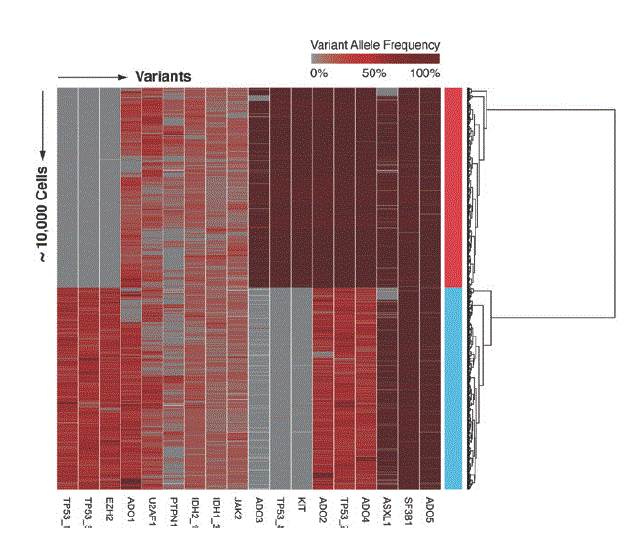Mission Bio stems from the work of Adam Abate at UCSF. The $79.5K benchtop instrument runs a workflow to encapsulate cells into microdroplets. Cell lysis and chromatin digestion within the droplets relies on proteases. PCR on the encapsulated DNA proceeds using both gene-specific primers and barcoding primers which tag the products from each cell. The initial assay design targets AML, with 40 amplicons at a list price of $795.
After this is complete, the emulsion is broken with detergents and a 10-cycle PCR protocol adds Illumina sequencing adapters to the amplicons. With a single 2x150 MiSeq run, 40-80X coverage is obtained for each amplicon for 10,000 cells. Mission Bio's software analyzes the raw sequencing data to visualize the genetic structure of the sample.

As noted by CEO Charlie Silver and CSO/co-founder Dennis Eastburn in our teleconference, the initial focus on AML is because it is documented to have significant heterogeneity and there is a strong unmet medical need. Better understanding of tumor genetic variability within a patient may assist in selecting the appropriate mix of therapies and detect earlier the rise of resistant clones. With this, it will be possible to explore whether cell-level resolution of tumor genetic structure can drive further improvements in precision medicine.
As sequencing capacities spiral ever higher, costs of raw data drop further and further. Note that Illumina just released their monster S4 chips for the NovaSeq rated at 6 terabases per run. Bulk sequencing can still be very informative in the correct setting, but these inexpensive data acquisition capabilities mean that a sequencer is becoming a generic measurement component. What it measures depends on the upstream sample and library prep, and Mission Bio is yet another example innovations in that space driving biology and medicine forward.


1 comment:
Sorry to post off topic, though the AI news is very big.
Alpha Go Zero, a reinforcement learning program, requiring Zero human
intervention is now the undisputed Go champion of the universe.
There is talk that this technology could be applied to protein folding and
perhaps genomics.
There is also speculation that this could lead to an AGI and then
the Singularity (i.e., the end of life as we currently understand it).
Comments?
Post a Comment